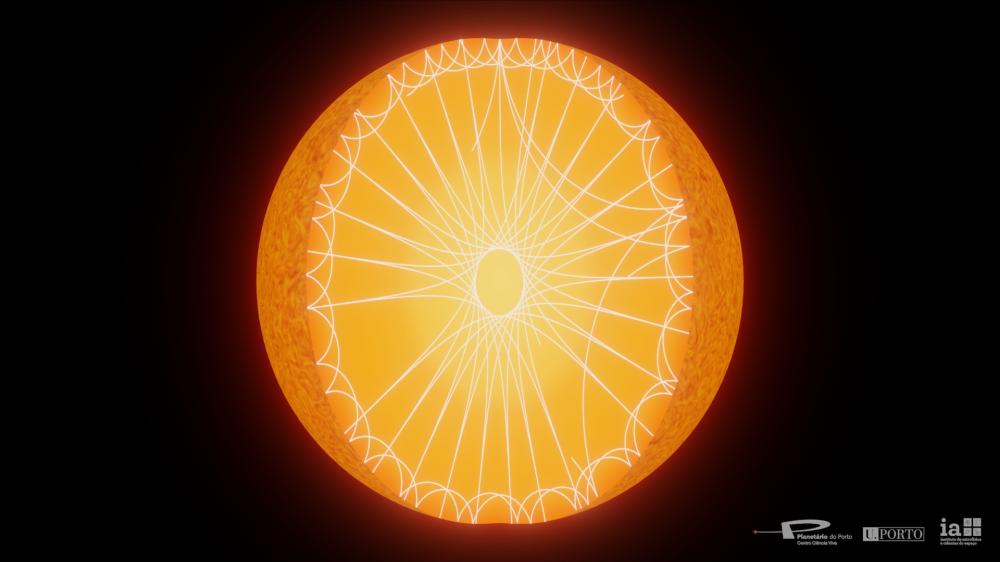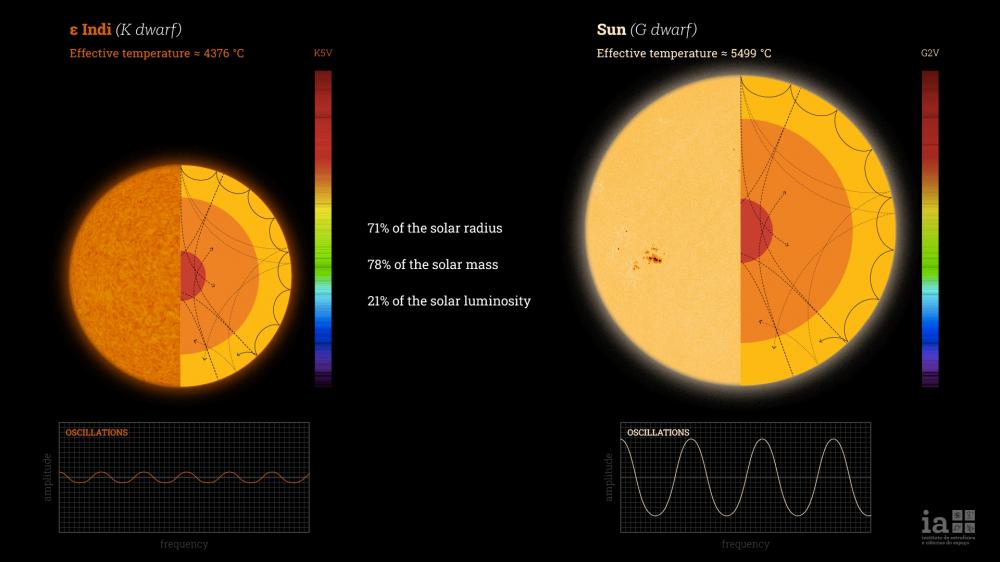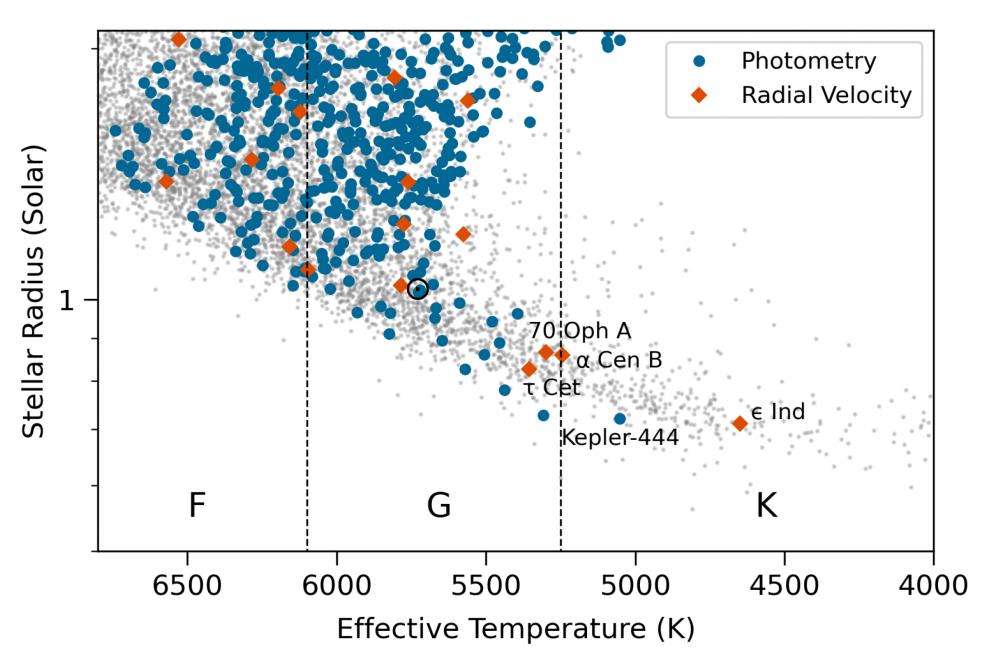Follow us on Google News (click on ☆)
This study demonstrates that asteroseismology is a powerful technique for studying such stars, opening new perspectives in our understanding of stellar physics and, consequently, exoplanets.

Artist's impression of seismic waves propagating within the star to layers of varying depth depending on their frequencies. Studying these different vibration modes at the star's surface informs us about the structure and composition of the various stellar layers, much like an echogram allows us to see inside our bodies.
Credit: Tania Cunha (Planetário do Porto - Centro Ciência Viva)/Instituto de Astrofísica e Ciências do Espaço)
This study has been published in the journal Astronomy & Astrophysics Letters: “Expanding the frontiers of cool-dwarf asteroseismology with ESPRESSO: Detection of solar-like oscillations in the K5 dwarf ε Indi”.
Incredibly precise measurements...
Located at a distance of 11.9 light-years, Epsilon Indi (ε Indi) is an orange dwarf star (also known as a K dwarf) with a diameter of 71% that of the Sun. To observe this small star, the team of scientists used the powerful ESPRESSO spectrograph, mounted on the Very Large Telescope (VLT) of the European Southern Observatory (ESO).
The team then used a technique called asteroseismology to measure the stellar quakes. These seismic oscillations, measurable at the surface of the star through photometry or radial velocity, are information-rich as they propagate in all stars. They provide a precise measurement of the fundamental stellar parameters (mass, radius, age) as well as an indirect insight into the interior of the star, such as its structure and composition, similar to how earthquakes inform us about the interior of the Earth.
In the case of ε Indi, the maximum amplitude of the detected oscillations is only about 1 inch per second (2.6 centimeters per second), which is 14% of the amplitude of solar oscillations, making it the smallest and coldest dwarf star observed to date with confirmed solar oscillations. These measurements are so precise that the detected speed is slower than the average speed of a sloth!

Infographic comparing the orange dwarf star ε Indi to the Sun. The detection of such weak oscillations opens many perspectives, both in stellar physics and in the study of exoplanets.
Credit: Paulo Pereira (Instituto de Astrofísica e Ciências do Espaço)
"The level of extreme precision of these observations is an exceptional technological achievement. It is important to note that this detection conclusively shows that precise asteroseismology is possible up to cool dwarfs with surface temperatures as low as about 7,600 degrees Fahrenheit (4200 degrees Celsius), about 1,800 degrees Fahrenheit (1000 degrees Celsius) cooler than the surface of the Sun, thereby effectively opening a new domain in observational astrophysics," comments Tiago Campante, lead researcher of the study and assistant professor at the Department of Physics and Astronomy of the Faculty of Sciences of the University of Porto (DFA-FCUP).
... that open many new perspectives!
This level of precision could help scientists resolve a longstanding disagreement between theory and observations regarding the relationship between the mass and diameter of these cold dwarf stars. "Models of stellar evolution tend to underestimate the diameter of K dwarfs by 5 to 15% compared to the diameter obtained by empirical methods. Studying oscillations in K dwarfs, via asteroseismology, will allow us to identify the gaps in current stellar models and, thus, improve them to eliminate this disparity," explains researcher Margarida Cunha, from the IA.
Despite initial skepticism about the possibility of detecting such oscillations beyond the current instrumental capabilities, Mário João Monteiro (IA & DFA-FCUP) explains that: "In addition to detecting the presence of solar oscillations in ε Indi, we now hope to use the oscillations to study the complex physics of the superficial layers of K dwarfs. These stars are cooler and more active than our Sun, making them important laboratories for probing key phenomena unfolding in their superficial layers that we have not yet studied in detail in other stars."

Diagram of stellar radius as a function of effective temperature, highlighting the seismic detections of the Kepler and TESS photometry campaigns (blue circles) and radial velocity (red diamonds). The dotted lines delimit the spectral classes of stars. ε Indi is the smallest and coldest star analyzed in asteroseismology.
Credit: Campante et al. 2024
Moreover, as orange dwarf stars and their planetary systems have very long lifespans, they have recently become a main focal point in the search for habitable worlds and extraterrestrial life. This result demonstrates that asteroseismology can be leveraged in the detailed characterization of such stars and their habitable planets, with truly extensive implications. Furthermore, the precise determination of the ages of nearby cold dwarfs made possible by asteroseismology can be crucial in interpreting biosignatures in directly imaged exoplanets.
Lastly, these "stellar shakes" can also be used to help plan the future PLATO space telescope of the European Space Agency (ESA), a mission with which the Department of Astrophysics is heavily involved. The oscillation amplitudes measured in this study are key information to help accurately predict PLATO's seismic yield, scheduled for launch in 2026.